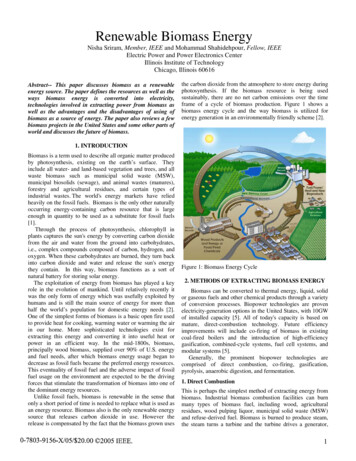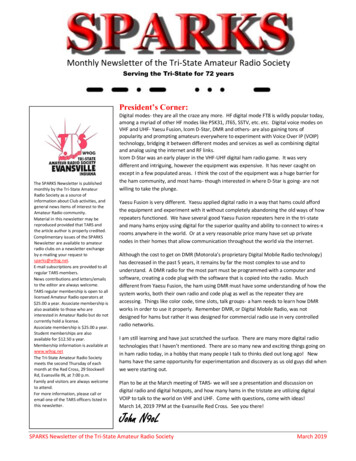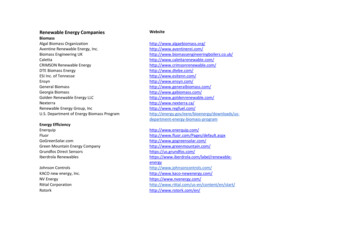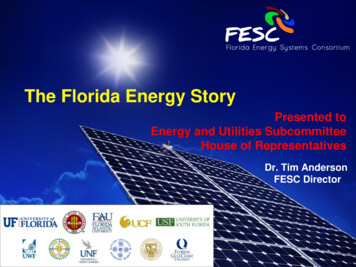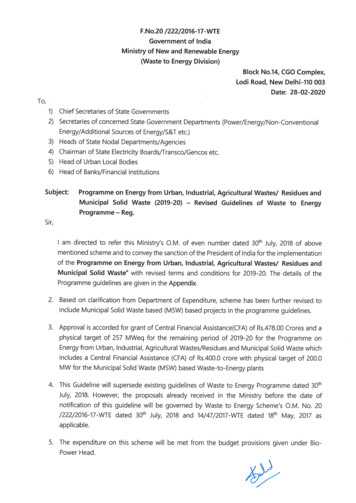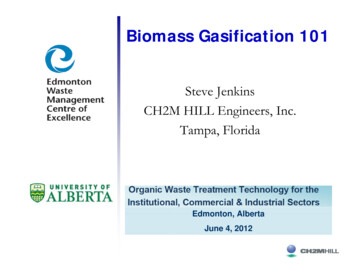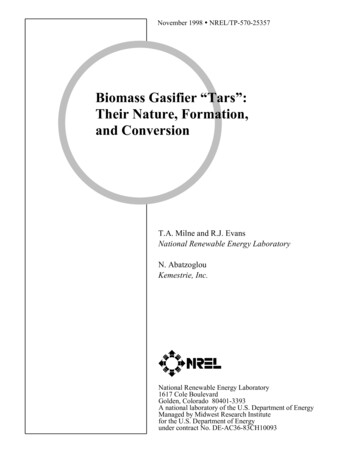
Transcription
November 1998 NREL/TP-570-25357Biomass Gasifier “Tars”:Their Nature, Formation,and ConversionT.A. Milne and R.J. EvansNational Renewable Energy LaboratoryN. AbatzoglouKemestrie, Inc.National Renewable Energy Laboratory1617 Cole BoulevardGolden, Colorado 80401-3393A national laboratory of the U.S. Department of EnergyManaged by Midwest Research Institutefor the U.S. Department of Energyunder contract No. DE-AC36-83CH10093
NREL/TP-570-25357Biomass Gasifier “Tars”:Their Nature, Formation,and ConversionT.A. Milne and R.J. EvansNational Renewable Energy LaboratoryN. AbatzoglouKemestrie, Inc.National Renewable Energy Laboratory1617 Cole BoulevardGolden, Colorado 80401-3393A national laboratory of the U.S. Department of EnergyManaged by Midwest Research Institutefor the U.S. Department of Energyunder contract No. DE-AC36-83CH10093Prepared under Task No. BP811010November 1998
NOTICEThis report was prepared as an account of work sponsored by an agency of the United Statesgovernment. Neither the United States government nor any agency thereof, nor any of their employees,makes any warranty, express or implied, or assumes any legal liability or responsibility for the accuracy,completeness, or usefulness of any information, apparatus, product, or process disclosed, or representsthat its use would not infringe privately owned rights. Reference herein to any specific commercialproduct, process, or service by trade name, trademark, manufacturer, or otherwise does not necessarilyconstitute or imply its endorsement, recommendation, or favoring by the United States government or anyagency thereof. The views and opinions of authors expressed herein do not necessarily state or reflectthose of the United States government or any agency thereof.Available to DOE and DOE contractors from:Office of Scientific and Technical Information (OSTI)P.O. Box 62Oak Ridge, TN 37831Prices available by calling 423-576-8401Available to the public from:National Technical Information Service (NTIS)U.S. Department of Commerce5285 Port Royal RoadSpringfield, VA 22161703-605-6000 or 800-553-6847orDOE Information Bridgehttp://www.doe.gov/bridge/home.htmlPrinted on paper containing at least 50% wastepaper, including 10% postconsumer waste
PREFACEThis literature study was commissioned by the IEA Bioenergy, Biomass Utilization Task XIII,“Thermal Gasification of Biomass” activity. At the invitation of Dr. Suresh Babu, Institute of GasTechnology, activity leader, the authors agreed to compile the following information pertinent to oneof the persistent problems in coupling gasifiers to energy conversion devices—the presence andmodification or removal of the organics historically called “tars.”The authors are grateful for the support of the IEA; CANMET, Canada, Bioenergy R&D, Mr. EdHogan, MRN Quebec, Energy from Biomass, Mr. Georges B.B. Le; the University of Sherbrookeand Kemestrie Inc. (NA); the U.S. Department of Energy Biomass Power Program, Dr. RichardBain, and Dr. Helena Chum at NREL (RE and TM), Ms. Stefanie Woodward (editor) NREL, andthe Library and Word Processing staff at NREL.This report will be issued under the auspices of the IEA Biomass Utilization Activity and will bepublished as an NREL technical report and appear on the NREL/DOE Power Home Page.*“When I use a word,” Humpty Dumpty said in a rather scornful tone, “it means just what I chooseit to mean—neither more nor less.” Through the Looking Glass, Lewis Carroll.i
ii
TABLE OF CONTENTSSummary . . . . . . . . . . . . . . . . . . . . . . . . . . . . . . . . . . . . . . . . . . . . . . . . . . . . . . . . . . . . . . . . .PagevConclusions and Recommendations . . . . . . . . . . . . . . . . . . . . . . . . . . . . . . . . . . . . . . . . . . . . viiI.Introduction . . . . . . . . . . . . . . . . . . . . . . . . . . . . . . . . . . . . . . . . . . . . . . . . . . . . . . . . . . .1II.Composition, Formation, and Maturation of “Tar” . . . . . . . . . . . . . . . . . . . . . . . . . . . . .3III.The Dependence of “Tar” Nature and Amount on Gasifier Type and Conditions . . . . . 13IV. The Dependence of “Tar” Measurement on Sampling, Treatment Protocols,and Chemical Analysis Methods . . . . . . . . . . . . . . . . . . . . . . . . . . . . . . . . . . . . . . . . . . . 22V.The Tolerance of End-Use Devices for “Tar” . . . . . . . . . . . . . . . . . . . . . . . . . . . . . . . . . 37VI.The Removal of “Tars” through Physical Processes . . . . . . . . . . . . . . . . . . . . . . . . . . . 43VII. The Thermal, Steam, and Oxidative “Conversion” of “Tars” . . . . . . . . . . . . . . . . . . . . 52VIII. The Catalytic “Destruction” of “Tars” . . . . . . . . . . . . . . . . . . . . . . . . . . . . . . . . . . . . . . 57References (See annotated bibliography in Appendix IV)Appendix I: A List of Major Compounds Found in “Primary Organics” . . . . . . . . . . . . . . . .A-2Appendix II: A List of Major Compounds Found in “Secondary Organics” . . . . . . . . . . . . .A-6Appendix III: A List of Major Compounds Found in “Tertiary Organics” . . . . . . . . . . . . .A-10.Appendix IV: Annotated Bibliography . . . . . . . . . . . . . . . . . . . . . . . . . . . . . . . . . . . . . . . . .A-12.LIST OF FIGURES2-1 Pyrolysis pathways (Evans and Milne 1987c) . . . . . . . . . . . . . . . . . . . . . . . . . . . . . . . . .32-2 “Tar” maturation scheme proposed by Elliott (1988) . . . . . . . . . . . . . . . . . . . . . . . . . . .42-3 “Tar” yield as a function of the maximum temperature exposure(Baker et al. 1988) . . . . . . . . . . . . . . . . . . . . . . . . . . . . . . . . . . . . . . . . . . . . . . . . . . . . . .52-4 The distribution of the four “tar” component classes as a function oftemperature at 300 ms (0.3 s) gas-phase residence time (reprinted fromEvans and Milne 1997) . . . . . . . . . . . . . . . . . . . . . . . . . . . . . . . . . . . . . . . . . . . . . . . . . . .7iii
LIST OF FIGURES (concluded)2-5 MBMS sampling of gasifier effluents run in the updraft and downdraftmodes (Reed et al. 1986) . . . . . . . . . . . . . . . . . . . . . . . . . . . . . . . . . . . . . . . . . . . . . . . . .82-6 TMBMS on-line analysis of Battelle Columbus (Gebhard et al. 1994a) andIGT (Ratcliff et al. 1995) gasifier tars . . . . . . . . . . . . . . . . . . . . . . . . . . . . . . . . . . . . . . .92-7 Composition of “tar” from atmospheric-pressure, air gasification of biomass at780EC (Bangala et al. 1997) . . . . . . . . . . . . . . . . . . . . . . . . . . . . . . . . . . . . . . . . . . . . . . . 114-1 BIOSYN sampling train used in Canadian R&D activities . . . . . . . . . . . . . . . . . . . . . . . 224-2 The dust and tar measurement method developed by DTI . . . . . . . . . . . . . . . . . . . . . . . . 244-3 Sampling train used by CRE Group, Ltd. (1997) . . . . . . . . . . . . . . . . . . . . . . . . . . . . . . . 266-1 Gas cleaning technologies . . . . . . . . . . . . . . . . . . . . . . . . . . . . . . . . . . . . . . . . . . . . . . . . 43LIST OF TABLES2-1 Chemical Components in Biomass Tars (Elliott 1988) . . . . . . . . . . . . . . . . . . . . . . . . . .53-1 “Tar” Reported in Raw Gases for Various Types of Gasifiers . . . . . . . . . . . . . . . . . . . . . 154-1 Comparative “Tar” Characterization, By Gasifier Type(CRE Group, Ltd. 1977) . . . . . . . . . . . . . . . . . . . . . . . . . . . . . . . . . . . . . . . . . . . . . . . . . . 275-1 Contaminant Constraints . . . . . . . . . . . . . . . . . . . . . . . . . . . . . . . . . . . . . . . . . . . . . . . . . 38iv
SUMMARYThe main purpose of this review is to update the available information on gasification “tar.” “Tar”is the most cumbersome and problematic parameter in any gasification commercialization effort. Forthis reason the IEA Gasification Activity has commissioned this work, which aims to present to thecommunity the scientific and practical aspects of (a) “tar” formation and (b) “tar” conversion orremoval during gasification as a function of the various technological and technical parameters andvariables.Historically “tar” was an operationally defined parameter, based largely on organics fromgasification that condensed under operating conditions of boilers, transfer lines, and internalcombustion engine (ICE) inlet devices. Such a definition requires a more detailed chemicalexplanation in light of the greatly expanded uses proposed for both high- and low-energy gas froma variety of biomass and waste materials. At present the literature contains many data on the“destruction,” “conversion,” “removal,” etc., of “tars,” “condensibles,” “heavy hydrocarbons,” etc.,without a consistent definition of these terms and a description of the sampling and analyticalmethods used for the organics of interest. Though the data presented are useful in the context of thesystem being studied, they are limited in their transfer to other systems because they are “apparatusdependent.”It is not within the mandate of this work to propose a widely accepted definition of “tar,” but ratherto report the varied use of the term. Hopefully this report will complement a recent effort of the IEAGasification Task [BTG/UTWENTE 1998] to reach a consensus among its members regarding suchan acceptable definition, as the first step in the adoption of a “tar” sampling protocol for the productfrom a variety of gasifiers, both high- and low-energy (producer) gas. Thus, within these limitations,this work suggests that “tar” is defined as follows:“The organics, produced under thermal or partial-oxidation regimes (gasification) of any organicmaterial, are called “tars” and are generally assumed to be largely aromatic.”Although this definition does not allow for distinction between classes and families of compounds,to be presented comprehensively in Chapter II of this report, it is a useful starting definition forgasification “tar.”Chapter III points out the main, and consequently the most practically important, differences in “tar”nature and quantities as a function of gasification conditions and applied technology. “Tar” naturealso depends on gasified feedstock and degree of feedstock contamination. A summary of the knownmechanisms of chemical formation and conversion during gasification regimes is presented andcommented on in Chapter II.Chapter IV undertakes a short presentation of “tar” sampling and analysis protocols used worldwideby workers and researchers in this field. A comprehensive report on this topic is available in theliterature. Nevertheless, in this chapter the authors have undertaken a comparison of the technicaldetails of a few of the sampling and analysis protocols, the aim being to relate facts with intrinsicdifficulties and encountered errors, and thus provide an insight into the efforts to formulate widelyaccepted protocols for “tar” identification and quantitative measurement.v
A very important, though not well studied, topic is the tolerance of gasifier gas end-use devices for“tar.” Data are available from R&D activities and from field experience, mainly coming frommanufacturers. In Chapter V there is a presentation of the gasifier-gas applications for energy andchemicals production, followed by a report of gas specifications for these processes. The reader hasaccess to a large amount of information regarding the content and nature of contaminant “tar” in fuelgases, but their impact on a variety of energy conversion and process applications is only beginningto be documented. One should contact manufacturers and involve them in the process leading tocommercial application as well as performance warrantees.Chapters VI, VII, and VIII deal with raw-gas cleaning technologies. They focus on tar removalthrough physical processes (Chapter VI) and “tar” conversion through thermochemical and catalyticprocesses (Chapters VII and VIII). The physical processes are classified into wet and drytechnologies depending on whether water is used. Cyclones, cooling towers/scrubbing columns,venturis, demisters/coalescers, cold and hot filters, baghouses, electrostatic precipitators, and wet-drycontactors/scrubbers are reported with sample literature coverage. Technologies available fortreating wastewater coming from wet-scrubbing processes are also briefly presented. They concernorganic solvent extraction, distillation, adsorption on activated carbon, incineration, biologicaltreatment, and wet oxidation. The choice of cleaning train depends on the specific application andthe results of technoeconomic evaluation that must be carried out before a process is selected.The chemical “tar” conversion processes are divided into four generic categories: thermal, steam,partially oxidative, and catalytic processes. Because of their particular importance as well as theintensive R&D work dedicated to them, the catalytic processes are analyzed and reported separatelyin Chapter VIII. Among these processes, catalytic steam reforming using dolomites and, moreefficiently, Ni-based catalysts seem of great importance and should lead to commercial applicationsin the near future, especially for gas use in gas turbines. It is widely accepted that physical cleaningtechnologies are suitable for gas use in boilers and ICEs (for downdraft gasifiers at least); hightemperature chemical “tar” conversion schemes may be required for gas turbine or high-temperaturefuel cell applications.The review is complemented with a selected bibliography on biomass gasifier “tars,” withannotations relevant to formation, nature, analysis, removal, conversion, and end-use devicetolerance. This bibliography is composed of some 400 publications. Comments/annotations aremeant to help interested readers select papers for their specific needs.In conclusion, we would like to reiterate our intention to provide the gasification community withan appropriately compiled resource regarding the important issue of “tar” presence in raw gas fromthe variety of gasifiers being developed.vi
CONCLUSIONS AND RECOMMENDATIONSComposition, Formation, and Maturation of “Tar”The characterization of “tars” as primary, secondary, and tertiary is a first step in classifying thesematerials and relating the composition of “tars” with formation conditions. Some gasifiers show thepresence of primary and tertiary “tar” constituents in the same “tar” sample, and this raises thequestion of the importance of process upsets and large, residence-time distributions that could causethis occurrence. This could have important implications in the design and operation of gasifiers toensure adequate control of reaction conditions. These “tar” constituents can be used as indicatorsof overall reactor performance and design (Brage et al. 1997b).Although past work has shown the systematic nature of “tar” composition as a function of reactiontemperature, more detailed study is needed to characterize the product at a higher level of detail.Some primary products will likely be more refractory to secondary thermal and oxidative crackingreactions than others, so an accepted method of characterizing the compound classes in each majorgroup is desirable and a method of rapidly screening for this information is needed. For example,it may be possible to “train” spectroscopic techniques to provide the necessary analysis based oncorrelation with more detailed work on a test system with GC/MS and other techniques that givehighly specific information, but are expensive to perform. Another approach is to identify “markercompounds,” or predominant constituents, which are indicators of overall chemical composition andto use methods to monitor these representaitve indicators of overall “tar” composition (Brage et al.1996).This chemical characterization could be correlated with key physical property data and processoperations, such as performance of wet scrubbing systems or catalytic cracking units. Primary,secondary, and tertiary classes are a starting point, but more detail is needed about the conversionof specific compound classes such as organic acids, which seem to persist beyond other primaryproducts.Kinetics and reaction pathways for primary to secondary and tertiary processes should be known sothey can be included in the design of gasifiers and cleanup systems. The qualitative and quantitativeeffects of oxygen and steam on product distributions should also be better known. More quantitativestudies are needed of primary, secondary, and tertiary products in fluid beds where residence timedistribution affecting reaction severity must be considered.Alternative feedstocks, such as herbaceous crops with high nitrogen content, raise questions aboutnitrogen-containing constituents. Analysis of these materials warrants more study.Finally, the pathways to soot and particulates, from tertiary products, require quantitative study tobetter ascertain the importance of these processes. This may be critical in hot-gas cleanuptechnology.vii
Recommendations:Once “tar” collection protocols are established, compound-class analysis methods and the analysisof predominant constituents should be established as standard procedures. Kinetic modeling of thesegroups should be attempted to help gasifier designers systematically address the relative importanceof process upsets and residence-time distributions in accounting for mixed product slates.“Tar” Levels from GasifiersThe results reported for “tar” levels from the three main categories of gasifiers, tabulated inTable 3-1, show a bewildering array of values, in each case (updraft, downdraft, and fluid-bed)spanning two orders of magnitude! Three of many reasons for this have no relation to the gasifierperformance per se, but are a result of the different definitions of “tar” being used; the circumstancesof the sampling; and the treatment of the condensed organics before analysis. There is generalagreement about the relative order of magnitude of “tar” production, with updraft gasifiers being the“dirtiest,” downdraft the “cleanest,” and fluid beds intermediate. A very crude generalization wouldplace updraft at 100 g/Nm 3, fluid beds at 10 g/Nm3, and downdraft at 1 g/Nm3. It is also wellestablished that well-functioning updraft gasifiers produce a largely primary “tar,” with some degreeof secondary character (assuming no oxygen is added in a second stage); downdraft gasifiers producean almost exclusively tertiary “tar;” and fluid beds produce a mixture of secondary and tertiary“tars.” In updraft gasifiers, the “tar” nature is buffered somewhat by the endothermic pyrolysis inthe fresh feed from which the “tars” primarily arise. In downdraft gasifiers the severity of final “tar”cracking is high, due to the conditions used to achieve a significant degree of char gasification. Influid-bed gasification a great variety of temperatures, environments, and circulation schemes arebeing tested, suggesting major improvements are coming. The nature of the feed material (forbiomass) is only a secondary influence on the nature of the “tar.”The amount of “tar,” not to mention the chemical making of the “tar,” from a given gasifier is afunction of the temperature/time history of the particles and gas; the point of introduction of feed influid beds; the thoroughness of circulation (in fluid beds); the degree of channeling (in fixed beds);the feed particle size distribution; the gaseous atmosphere (O2, steam); the geometry of the bed; themethod of “tar” extraction and analysis. In view of this, it did not seem worthwhile to try torationalize the amounts of “tar” report in Table 2.1, except in the broadest terms.Recommendations:The two most helpful things that researchers and operators could do in reporting raw-gas “tar” levelswould be to clearly highlight the condensation, sample preparation, and analytical methods used andthe end use to which the definition of “tar” is being applied. As an example, in the context ofoperating ICEs, one might be collecting only organics condensing above, say, 100EC; weighing thecondensate; and not considering light hydrocarbons and benzene or toluene. At the other extreme,in a projected use of the gasifier output for an internally reforming solid-oxide fuel cell, the entiresuite of organics, particularly olefines and aromatics, might need to be specified. At the last IEAGasification Task meeting (Brussels, March 1998), it was stated that “all organics boiling attemperatures above that of benzene should be considered as ‘tar.’”viii
“Tar” MeasurementsThe biggest issue, which confuses the meanings people apply to “tar” and the intercomparability ofresults from various researchers, are: the conditions and solvents used for “tar” collection; and thesubsequent solvent separation. The variety of analytical characterizations of the collected materialgives different views of the makeup of the organics, but if clearly documented, does not mislead thereader. As detailed earlier, the temperatures, trapping schemes, and solvents used to capture organicsvary extremely. Capture temperatures from -78EC to 190EC, with many temperatures in between,are reported. Single-to-multiple vessels are used, containing solvents such as acetone, methanol,dichloromethane, methylene chloride, and toluene. Solid sorbents such as cellulose, fiber glass, andamino-bonded silica (Brage et al. 1997a) are also used. Sometimes the collection of aerosols of “tar”is mentioned. The extraction of the organic fraction of ash, char, and soot is seldom considered.Losses of solvent during sampling is also a concern when “tar” is measured gravimetrically,especially for gases with low “tar.”Some measurements of the organics in the condensate do not require separation of the solvent orwater. In most cases, however, a pre-separation or extraction is used, especially when weight is themeasure. Solvent removal has been reported by distilling at 75EC to 150EC; by evaporating at 25ECto 105EC under ambient to 10-mm Hg pressure; by air-drying at room temperature or at 93ECovernight; and by organic partitioning; depending on the fraction of “tar” that is of interest to the enduse being studied. As one example of the large difference in quantity of “tar” being reported, Aldénet al. (1996) note that the “total tar” can be six times the commonly measured “condensable tar.”There are issues in the probe design that are not always explicitly discussed. Probe and lines mustbe at a high enough temperature to prevent condensation of the least volatile tar component ofinterest, but not so high as to cause additional cracking or interaction with particulates of whatevernature. Because some of the tar can be in aerosol form or reside on ash, char, or soot particulates,isokinetic sampling would seem to be a prudent practice.Recommendations:A number of sampling methods, specific to biomass and the predominant measure of organics forcategories of end use, need to be standardized. These should include probe conditions; collectiongeometry and conditions; and solvent use and removal. To support these standards, research needsto be carried out on the fractions of organics that are captured and removed from the solvents beingused for primary, secondary and tertiary “tars.” As noted earlier, and following the suggestions inthe literature, a widely recognized standards organization, in collaboration with other standardsgroups and the IEA gasification task, should lead this activity (BTG 1995b; Kurkela et al. 1995a;Salzmann et al. 1996; Ståhlberg and Kurkela 1990; Brown 1996; Easterling et al. 1985; Techwest1983; CRE 1997; Delgado et al. 1997).This issue of standards is currently being addressed, as is documented in the University of Twenteweb site: http://bgt.ct.utwente.nl/projects/558/(BTG/TWENTE 1998) and by the IEA GasificationTask (Brussels, IEA 1998).ix
Tolerance of End-Use Devices for “Tar”There are very few well-defined and long-term data on the tolerance to “tar” of the great variety ofenergy conversion devices now being considered for gasifier output (boilers excepted). The olderliterature focused primarily on ICEs for automotive use. More recently, applications of the gas tofire turbines have been in the forefront. In almost no applications, except close-coupled boilers, haveendurance tests or operations been carried out long enough to give valid projections of maintenanceand systems costs. When such tests are done it will be most valuable if the offending organics areclearly identified so the results can be generalized. The studies going on in coal gasification, withcoupling to turbines, engines, fuel cells, etc., should provide valuable information, particularly whenhighly cracked or tertiary “tars” are involved. Such “tars” are remarkably similar for biomass andfor coal.Recommendations:Governments and developers should support long-term, well-controlled tests on engines (industrialand automotive), internally and externally fired turbines, fuel cells, and the variety of externally firedsystems such as Stirling engines, where heat transfer materials and geometry differ from simpleboilers. The nature of the “tar” involved in these tests should be well defined.Tar Removal through Physical ProcessesPhysical processes will continue to play a very important role for the successful commercialimplementation of gasification. They constitute the basic arm for removing most of the raw gasifiercontaminants, including “tar.” “Tar” is removed mainly through wet or wet-dry scrubbing.Coalescers, demisters, and cold filtration are also necessary supplements. These well-knowncommercial methods are easily designed and applied, depending on the specific needs of anygasification process. The main problem arising from “tar” scrubbing is that condensed “tar”components are merely transferred into another phase (water or solids such as scrubbing lime), whichthen has to be disposed of in an environmentally acceptable manner. The problems associated withthe management of these wastewater or solid residues are summarized as follows: “Tar” and “tar”-contaminated solid-waste streams are considered as a special waste;consequently, their disposal is usually cumbersome and costly. “Tar”-bearing wastewater is usually a bi-phasic mixture requiring various steps of treatmentbefore final disposal. Most water-soluble “tar” components are refractory to the usual biological wastewatertreatments.The applied methods for “tar” and “tar”-containing waste streams include solid waste stabilizationand landfilling, organic phase skimming off the bi-phasic wastewater-free surface, wastewaterincineration, wet oxidation, adsorption on activated carbon, and final biological treatment.x
Recommendations:Although chemical (mainly catalytic) conversion of “tar” at high temperature for eventual use of thegas in gas turbines attracts more and more attention, it is expected that physical removal of “tar” willcontinue to be widely used because: Burners/boilers that are not close coupled, as well as ICEs, require cold-gas use; it is ratherdifficult to envision, without serious economic problems, the simultaneous use of hightemperature “tar” conversion reactors combined with cold-gas conditioning modules. Thus, wetor dry-gas cooling/scrubbing is the recommended method in such cases When high-temperature conversion of “tar” is used there remain in the producer gas some othercontaminants (mainly acid gases and volatile alkali metals), which could be detrimental to gasturbines. Thus, cold-gas conditioning, or in-series guard columns, should be used for thesecontaminants.Extensive development work in this field is recommended. Government and private funding shouldbe devoted over the next 5 years, to improve scientific understanding and technical/technologicalknowhow on physical “tar” removal from raw producer gas. This work should focus on: Wet scrubber design for higher efficiencies Aerosol removal module design and efficiency measurement Water insoluble “tar” skimming Skimmed “tar” recycle back to the gasifier; reactivity as a function of the recycle stream natureand quantity; rules for calculating the steady-state conditions Use of carbon-rich ashes from the gasifier to supplement the adsorption of “tar” on activatedcarbon; scale-up of bench-scale systems and establishment of design parameters Optimization of wet-oxidation conditions for treating soluble “tar” containing wastewater. Studyand optimization of deep-bed, cold filters for “tar” removal; life cycle analysis.xi
Thermal, Steam and Oxidative “Conversion” of “Tars”ThermalThe consensus seems to be that temperatures in excess of 1,000EC, at reasonable residence times,are necessary to destroy the refractory unsubstituted aromatics without a catalyst. Apart from theeconomics and materials problems, such thermal decomposition can produce a soot that can be evenmore troublesome for some processes than the aromatics. Benzene seems to be the least reactive,thermally, of the light aromatics.SteamThe addition of steam, over and above that formed from the water and oxygen in the feedstock, hasbeen reported to produce fewer refractory tars, enhance phenol formation, reduce the concentrationof other oxygenates, have only a small effect on the conversion of aromatics, and produce “tars” thatare easier to reform catalytically.Partial OxidationOxygen or air added to steam seems to produce more refractory “tars” but at lower levels, whileenhancing the conversion of primaries. When oxygen is added selectively to various stages, suchas in secondary zones of a pyrolysis-cracker reactor, “tars” can be preferentially oxidized.The Catalytic “Destruction” of “Tars”Many types of catalysts have been investigated to reduce “tars” to lower levels and at lowertemperatures than by thermal, oxidative, or steam reforming alone. Non-metallic catalysts such asdolomites, and metallic catalysts such as nickel (Ni), have been extensively studied. When used insitu, the results have not been promising due to a combination of coking and friability. Secondarybeds have been much more effective for both types of catalysts. Even more promis
National Renewable Energy Laboratory N. Abatzoglou Kemestrie, Inc. National Renewable Energy Laboratory 1617 Cole Boulevard Golden, Colorado 80401-3393 A national laboratory of the U.S. Department of Energy Managed by Midwest Research Institute for the U.S. Department of Energy under contract No. DE-AC36-83CH10093 Prepared under Task No. BP811010
